The BLS JOLTS report shows very high job openings, just slightly down from September. Actual hiring overall did improve slightly from the previous month and is finally just barely at prerecession levels. The Job Openings and Labor Turnover Survey shows there are now 1.5 official unemployed per job opening for October 2015. Job openings were 5.4 million while hires were 5.1 million. The soaring job openings give an illusion of a red hot jobs market, but openings exceeding hires levels paints a different picture.
There were 1.8 official unemployed persons per job opening at the start of the recession, December 2007. Below is the graph of the official unemployed per job opening, currently at 1.47 people per opening. This ratio rivals June 2001 levels.
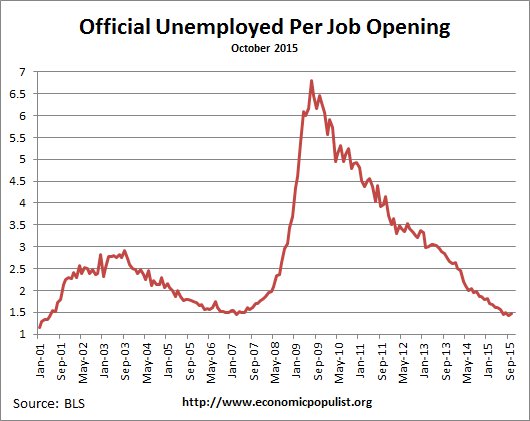
If one takes the U-6 broader measure of unemployment that includes people who are forced into part-time work and the marginally attached, the ratio is 2.9 people needing a job to each actual job opening. In December 2007 this ratio was 3.2. Here too we see great ratios regarding job openings. This is the lowest ratio since September 2007.
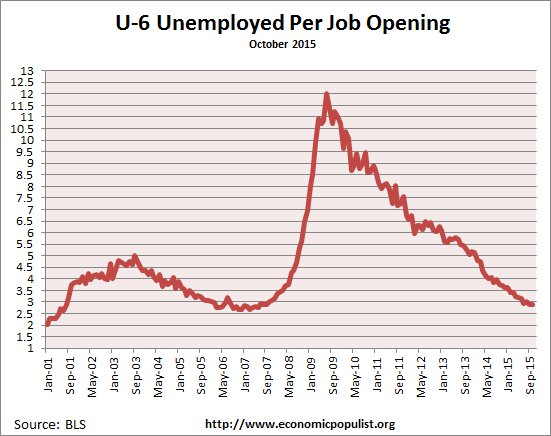
Job openings are soaring past pre-recession levels and for the past year have exceeded hire levels. Currently job openings stand at 5,383,000.

Below is the graph of actual hires, currently 5,137,000. Since the June 2009 trough, actual hires per month have increased 41%. Recession hiring really didn't cliff dive like layoffs, firings and openings did, yet for months now openings have soared. Now in October the ratio to hires vs. openings did slightly improve. In the private sector alone, hires are now 1.3% below their November 2007 prerecession level. None of these levels and figures are adjusted for population growth, which shows how badly the labor pool has really shrunk. Also, Businesses can say there have job openings, but if they do not hire an American and fill it, so what about the reported opening? The tech industry is notorious to put out false job ads with no intention of hiring an actual American worker. Tech companies and now other sectors put out fake job openings to claim they have a labor shortage in order to demand more guest worker Visas in order to import cheap labor. This undercuts and displaces those workers who are U.S. citizens.

Graphed below are total job separations, currently at 4.863 million. The term separation means you're out of a job through a firing, layoff, quitting or retirement and is also called turnover. From a year ago, separations are almost at the same level, 4,906,000, which shows an extremely stable job market churn for workers.
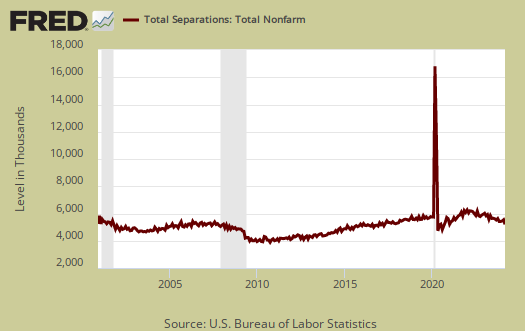
Layoffs and firings were 1.67 million, a -6.5% monthly change, which is a typical monthly swing. Below is a graph of just layoffs and firings. One can see from labor flows businesses are not thrashing their workforce as much, relatively speaking, for some time in 2015. Labor flows means the way people are hired, stay at a job, quit, get fired, get another job and so on. It is the overall flow of the labor market for as people are get jobs, they also lose them.
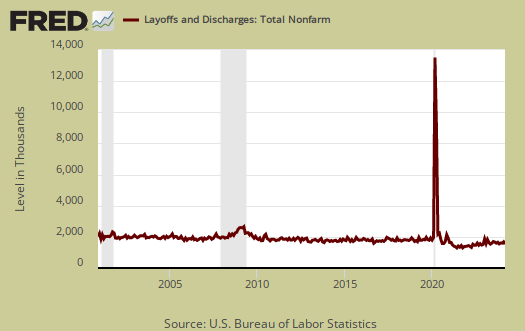
Graphed below are openings, separations and hires levels, so we can compare the types of labor flows. While layoffs have declined to pre-recession levels, it is the hires (blue) that needs to increase even more. The below figures also disprove a labor shortage since one would have more job openings than the unemployed.
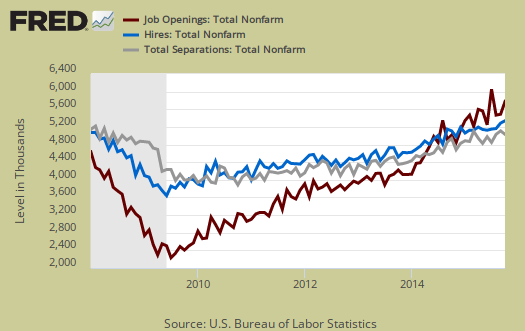
Graphed below are people who quit their jobs minus those who were fired and laid off. The lower the bar on the below graph, the worse labor conditions are. Quits are what they sound like, workers quit their current jobs often to obtain better ones. People feeling free enough to leave their current positions is considered a positive labor market sign. Quits were 2.779 million. Quits are still below pre-recession levels.

Below is a graph of the quits to layoffs ratio, currently at 1.7 and hasn't changed much. In the private sector, quits are still 2.0% below their prerecession levels. This ratio of people who quit their jobs vs. those who were fired gives an indicator of worker churn as well as if there might be a shortage. If the ratio is below 1.0, this means more people are being laid off and fired than people who quit. When the ratio is much higher, this means more people quit their jobs and thus implies there is better opportunity elsewhere and workers feel free enough to move on to obtain those new better jobs. The quits to fires ratio was 1.9 in 2006.
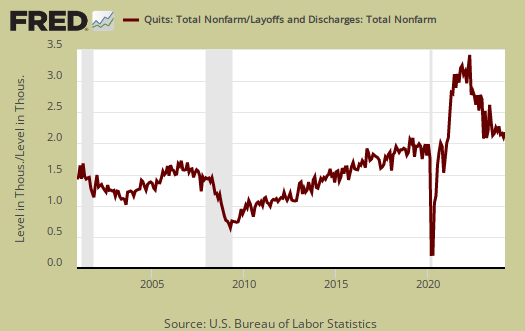
For the year, there was a gain of 2.7 million employed and in spite of different employment reports the net job gains hasn't changed in the last six months. Thet duration in so called permanent jobs these days is very low, so due to labor flows the net gain of jobs over time belies the monthly headline buzz of jobs gained. From the JOLTS report:
Over the 12 months ending in October 2015, hires totaled 61.0 million and separations totaled 58.3 million, yielding a net employment gain of 2.7 million. These totals include workers who may have been hired and separated more than once during the year.
The BLS publishes highlights in a separate report and the analysis on hires is most telling. For the first time in report history, there is a pattern of more openings than hires. That's not a good thing and by focusing in on openings versus hires, one gets a false impression the jobs market is better than it actually is. Here are the BLS bullet points which imply the lack of hires is most troubling:
- The number of hires has exceeded the number of job openings for most of the JOLTS history. Over the past year, this relationship has changed as job openings have outnumbered hires for several months.
- Hires exceeded job openings for over thirteen years, between December 2000 and July 2014. Job openings exceeded hires for the first time in August 2014, although hires then outnumbered job openings for the next five months. Since February 2015, however, this new relationship has persisted with job openings exceeding hires for nine consecutive months.
- At the end of the most recent recession in June 2009, there were 1.3 million more hires throughout the month than there were job openings on the last business day of the month.
- In October 2015, there were 246,000 fewer hires throughout the month than there were job openings on the last business day of the month.
For the JOLTS report, the BLS creates some fairly useful graphs beyond the above and they have oodles of additional information in their databases, broken down by occupational area. That said, one doesn't know if the openings are quality jobs from the JOLTS statistics.
The JOLTS takes a random sampling of 16,000 businesses and derives their numbers from that. The survey also uses the CES, or current employment statistics, not the household survey as their base benchmark, although ratios are coming from the household survey, which gives the tally of unemployed.
The October 2015 unemployment rate was 5.0%. U-6 alternative unemployment rate was 9.8%. JOLTS includes part-time jobs and does not make a distinction between part-time, full-time openings. A job opening reported to the survey could literally be take out the trash twice a week and be counted. This is a shame, it would be nice to know a little more about the quality of these new opportunities. Here are our past JOLTS overviews, unrevised.

*Newsflash!* Shitty jobs
*Newsflash!* Shitty jobs exist, some people take them, some refuse. It looks like this awful development has been going on... since the beginning of time.
No one is entitled to a good job.
No one is entitled to a job.
It has always been this way. Having outrage now, doesn't change this fact.
Jobs...shitty or not
We are all "entitled" to have a genuine opportunity for a decent job (better than "shitty"). At least as entitled as a corporation is to make a large profit, and a CEO to live in a mansion. Haven't we created our society to benefit everyone?? If not, we need to redo things.
Openings exceeding hires is
Openings exceeding hires is probably a good thing for workers but a bad thing for inflation. The news is full of reports of trucker shortages, construction worker shortages, and even Walmart raising wages to keep competitive. The companies hold off at first hoping to get someone at their current salary and eventually give in and raise pay for everyone. This is just the beginning of wage inflation I think. It will be 4% soon enough.